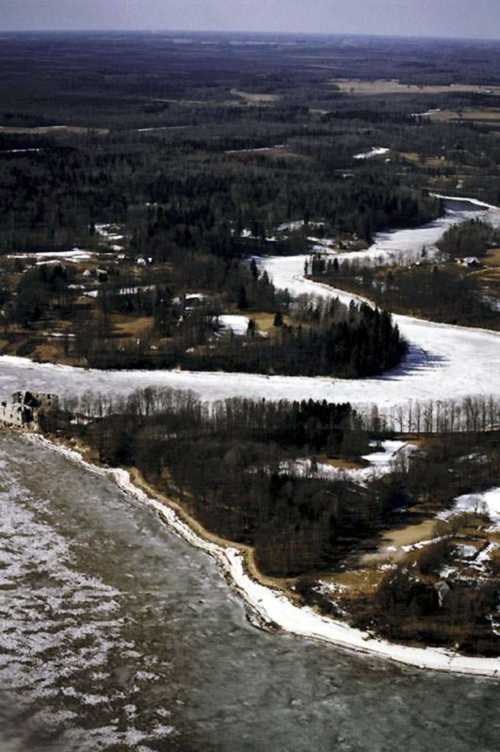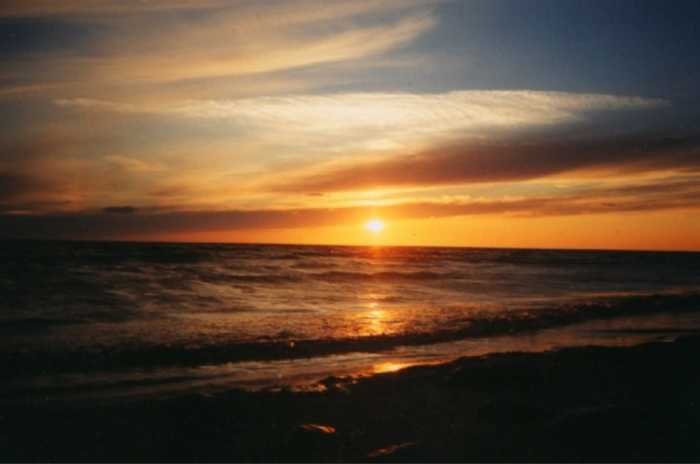


 |  |  | 19.13 Eutrophication in the Gulf of Riga: fiction or reality? |
Assuming that the bioavailable N and P from the rivers [282] would be spread over the entire Gulf, the annual supply would be 0.57 and 0.016 g m-2 for N and P, respectively. Assuming further that the euphotic zone is 10 m deep and that the nitrate and phosphate concentrations at the end of the winter are 20 and 0.6 muM, respectively [449], it becomes obvious that the river supply to the winter-accumulated N and P in the euphotic zone is moderate: 20 and 15 %, respectively. However, as the spreading of freshwater in the Gulf is dependent on runoff variations and meteorological forcing [443], the effect of nutrient supply [473] and suspended biomass [387][28] in the southern part can vary considerably. Also, wind mixing induces new nutrients to the euphotic zone. The greatest impact of nutrients is confined to the southern area and consequently new production is significantly increased.

A rough estimate of the autochthonous supply of P to the euphotic zone shows that it is less than half of what is delivered to the Kattegat. As compared to the high primary production rate [351], the relatively small vertical export of biogenic matter from the euphotic zone [295], the small new production [351], the insignificant contribution of phytoplankton cells to the vertical export after the vernal bloom [356] and the prevalence of detritus and faecal matter [295] point at high pelagic recycling efficiency in the Gulf. The buffering capacity of excess suspended biomass in the pelagial causes the prevalence of retention rather than export food chains. Consequently, the effect of external perturbations such as increased nutrient supply is reduced accordingly. The main supply of fresh biogenic matter to the benthos is defined by the extent of the vernal bloom and the complexity and efficiency of the seasonal development of the planktonic community structure. As the duration and start of the spring bloom can change as a consequence of variable seasonal and annual nutrient discharge to the Gulf as well as climatic factors such as ice-cover, wind forcing, solar radiation and the spectral light composition (clouds, fog etc.), the time window in which vernal phytoplankton is exported to the benthos is variable.
As the supply of nutrients to the Gulf depends strongly on the seasonal and interannual variability in river runoff, which can double during years of increased precipitation as compared to dry years, the allochthonous supply of nutrients varies accordingly. Thus also the interannual new production and the extent of eutrophication vary. Nutrient removal of bioavailable N and P from coastal point sources would only relieve the N budget of the Gulf by 9 %, that of P however by 44 % [282]. Obviously a removal of P from coastal point sources would reduce the P budget of the Gulf significantly and even N removal would to some extent mitigate the N burden.
Nutrient removal from point sources such as the city of Riga will reduce the eutrophication in both the southern littoral zone as well as in those offshore areas of the Gulf that are under direct influence of the river Daugava. Clear evidence of downward trends in the nutrient loadings of rivers related to the rapid economical recession in the catchment area were so far not recorded [282]. Thus, the allochthonous supply of nutrients to the Gulf by rivers from diffuse sources (e.g. agriculture) will basically continue in the future. The general eutrophication of the Gulf will probably only decline when both nutrient removal at coastal point sources is introduced and the use of fertilisers and manure is kept continuously low over lengthy periods of time. Also, measures ought to be taken to limit the effect of modern forestry on nutrient discharge, to constrain the introduction of deserted farms into modern agriculture, to eliminate drainage of former wetland areas and to increase the vegetation along rivers and small streams in intensive agricultural areas. These measures will jointly increase the denitrification in the drainage basin or constrain the discharge of nutrients to small catchment areas. Finally, reduced emissions of P and organic matter from point sources in the drainage basin may, under certain conditions, reduce the denitrification capacity in rivers [86]. Therefore, it cannot be ruled out that the N loads to the Gulf of Riga may increase in the future, regardless of modernisation in the agricultural sector and nutrient removal from point sources along rivers [440]. Accordingly, it is difficult to predict changes in both the total nutrient discharge to the Gulf and the N-P-DSi composition of the waters in the Gulf.
Eutrophication in coastal waters is not only characterised by substantial additions of P and N, but also by the fact that the supply of DSi is more or less constant or subjected to natural runoff patterns [424][479]. There is also a tendency for DSi supply to the sea to decrease over time in many eutrophied rivers [473]. This is explained by increased growth of freshwater diatoms in the river due to increased N and P concentration, and subsequent sedimentation of diatoms behind dams. There seems to be evidence for declining DSi supply also from the Gulf of Riga [282]. However, there are several dams along the river Daugava that were built already before nutrient records became available. Thus, DSi supply to the Gulf must have been reduced already for several decades. Scenarios where the relative concentration of DSi is decreased while that of N and P is increased, favour the growth of non-DSi dependent forms such as flagellates. The resulting change in phytoplankton species composition results in increased residence times of the phytoplankton-derived organic matter in the upper layers because aggregate formation and the relative contribution of rapidly sedimenting diatom blooms decreases. DSi obviously plays an important role for eutrophication as emphasised by Officer and Ryther [347] and Conley et al. [104]. The increasing gap between decreasing DSi, but increasing N supply results in a decreasing significance of diatom and increased potential of nuisance blooms.
The high buffering capacity of the pelagial confines the vertical supply of biogenic matter to the benthos. However, the supply of biogenic matter to the benthos and the main accumulation bottom derives probably from advective transport from the slope, the river plume and the littoral zone where erosion of fine biogenic matter results in a predominance of hard substrate (D. Conley, pers. comm.). The effect of frequent resuspension episodes, weather-controlled bottom currents which regularly and easily entrain organic matter from the sediment-water interface [155], as well as sediment focusing, add to the supply of food for the benthos at depth. Here biogenic matter from the surface accumulates on an area which is less than half that of the entire surface area, creating favourable growth conditions for the benthos.
Statements that regard the Gulf of Riga as an eutrophic to hypertrophic area seem not to be valid. The data of Laznik et al. [282] and Tamminen and Seppälä [456] indicate that the nutrient supply to the Gulf, as well as the concentrations in the water body, are similar to or less than that of other Baltic Sea areas (e.g. the middle/eastern Gulf of Finland or the Kattegat. In contrast to previous assumptions the Gulf of Riga is basically N- and only periodically P-limited. Furthermore, it has a high pelagic buffering capacity with regard to nutrient discharge induced by efficient recycling by the pelagic food web, which limits the occurrence of massive algal blooms. Nevertheless, the pollution loads from the rivers, in particular those originating from the catchments of the Daugava and the Lielupe rivers, have contributed to an overall eutrophication of the Gulf of Riga, with a continuously shifting gradient between the southern and northern halves of the Gulf. As the simple and exposed topography of the basin makes it exceptionally prone to physical forcing, it is obvious that episodic mixing events can cause considerable interannual and within-season variability in the production preconditions and nutrient limitation of the planktonic community, especially towards late summer and early autumn.

 |  |  | 19.13 Eutrophication in the Gulf of Riga: fiction or reality? |